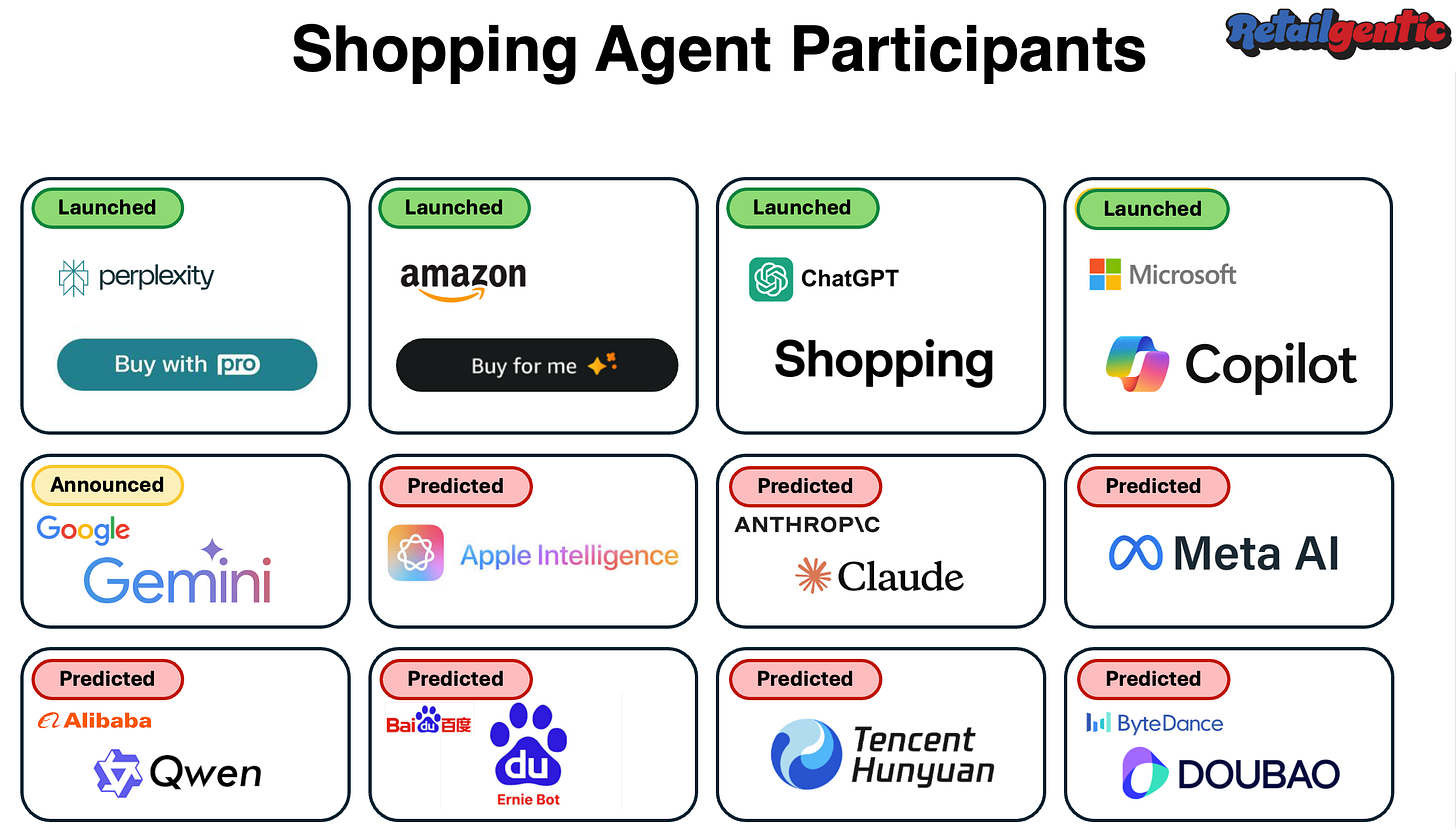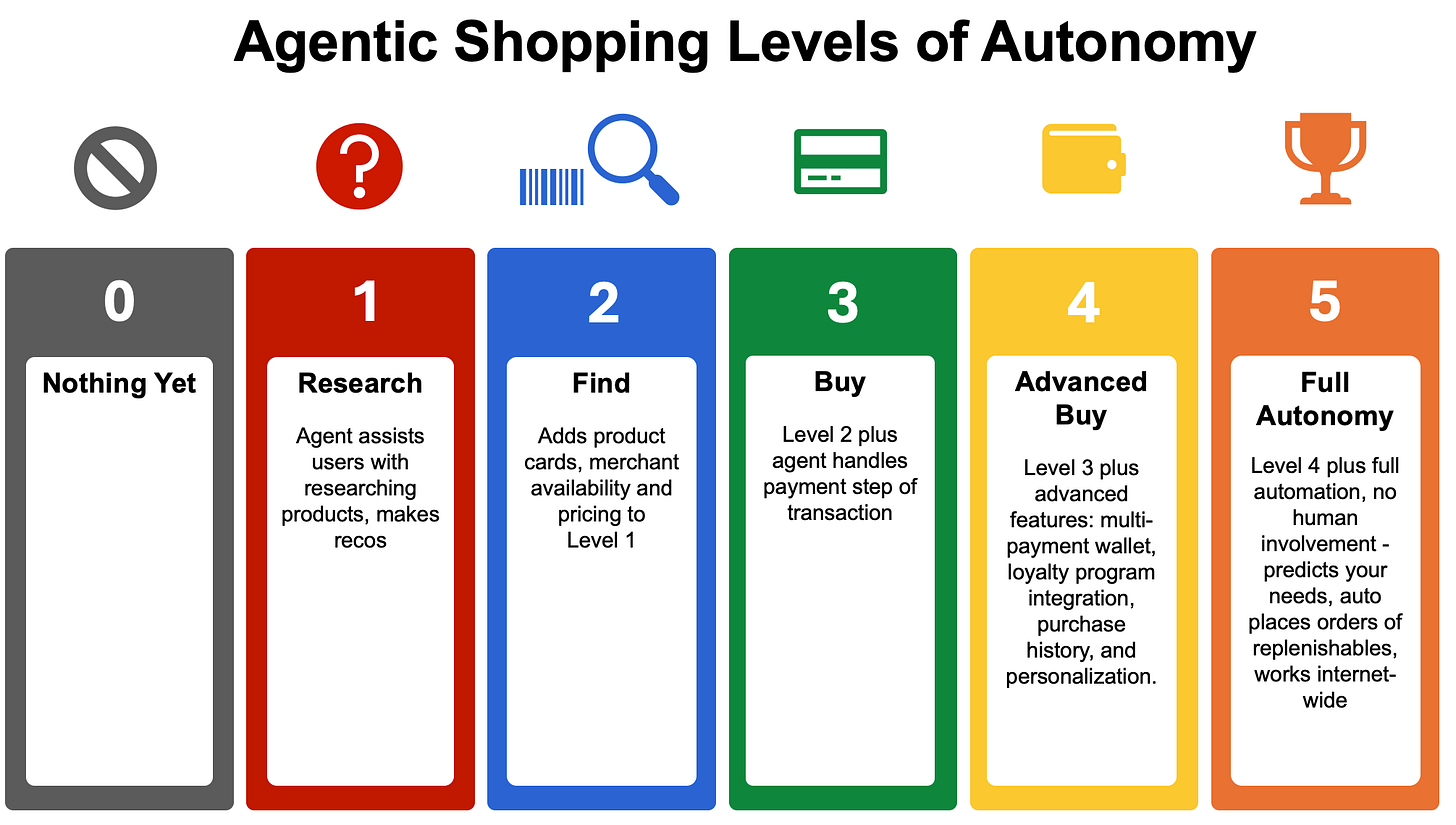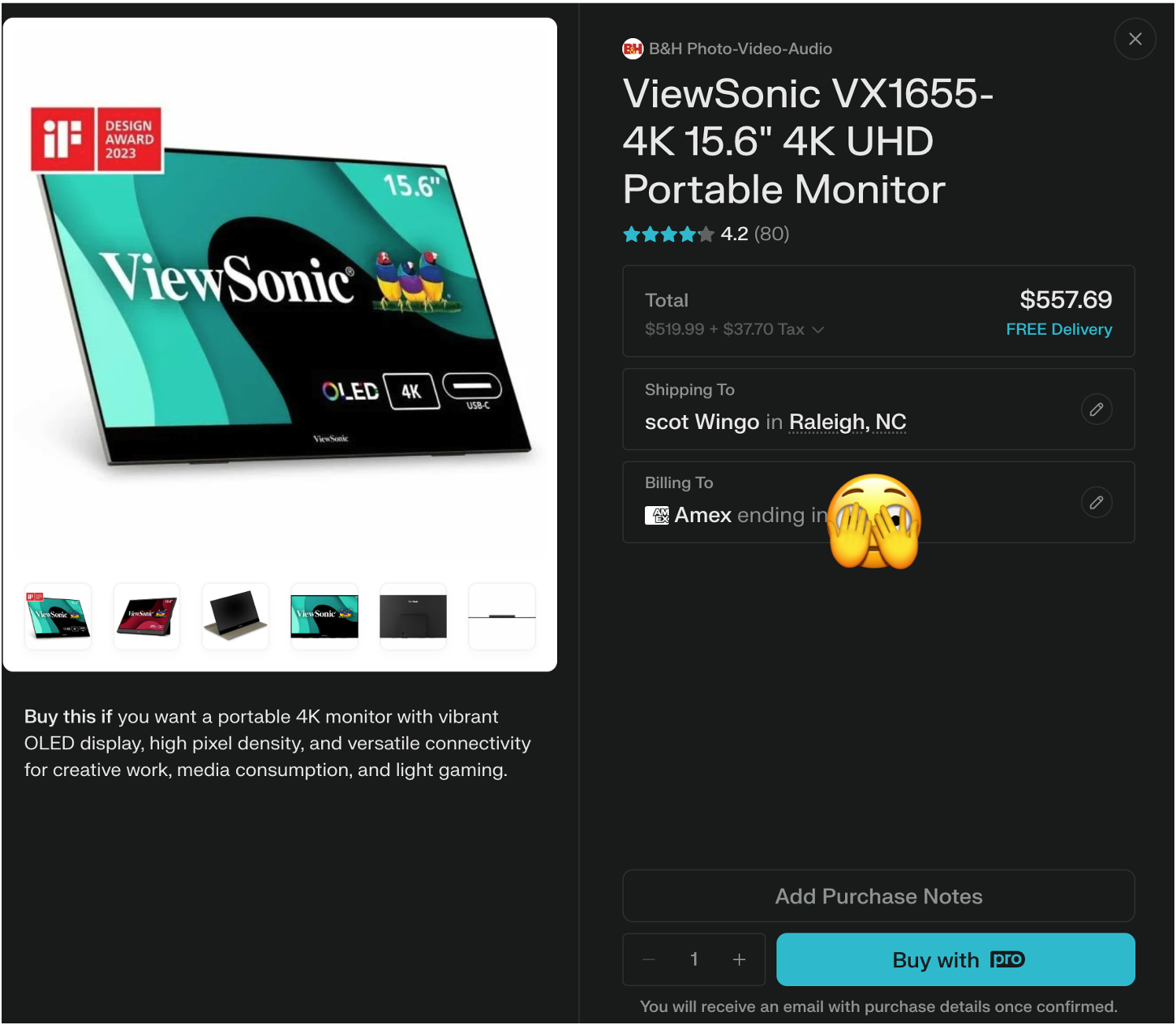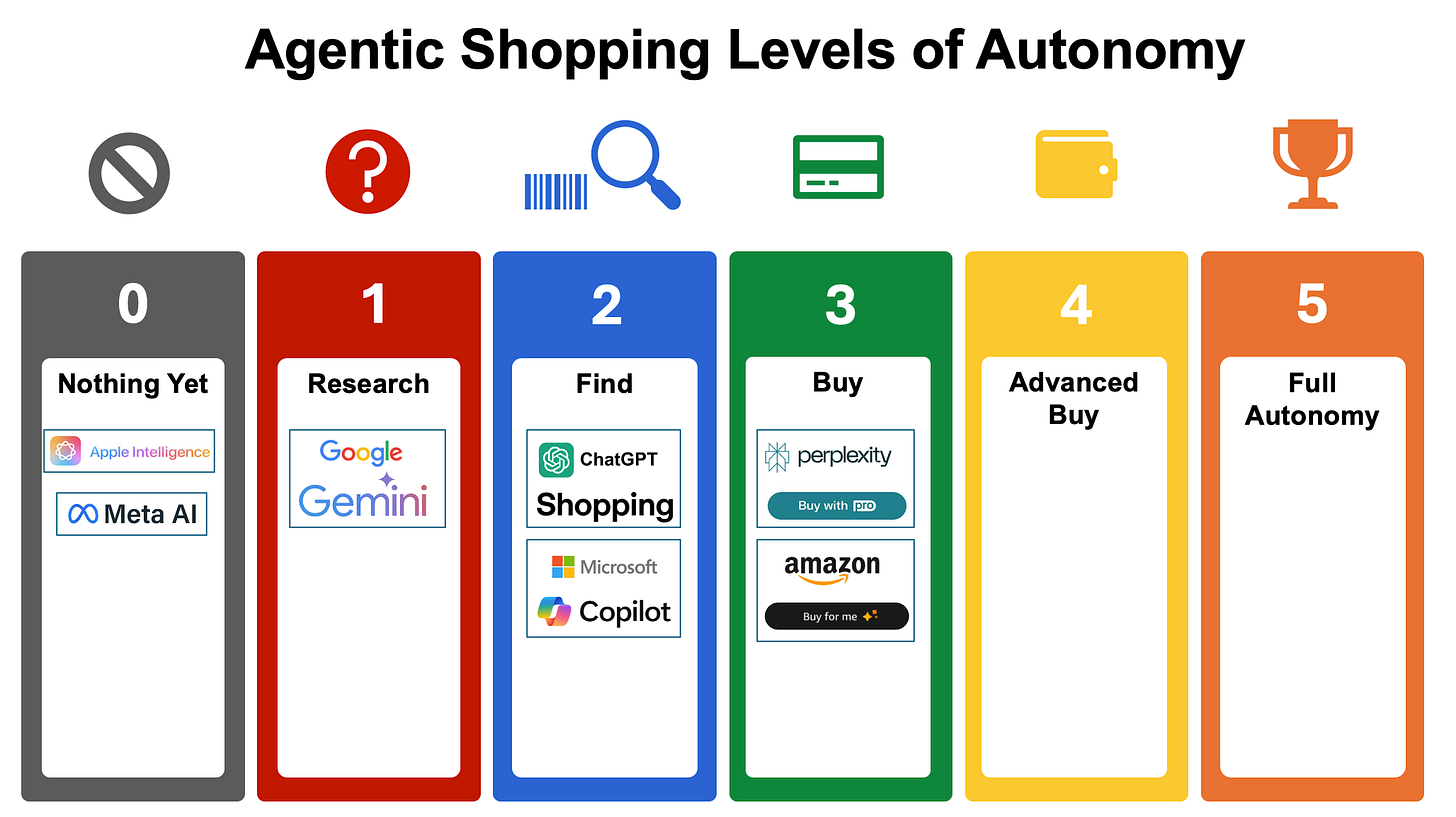Introducing the 5 Levels of Agentic Shopping Framework
As an industry how do we track the state and progress and 'what's next' for agentic shopping? We have a solution!
As we’ve been talking to retailers, brands, vendors and agencies in the digital retail ecosystem, a common question that comes up is: “Which of the Agentic Shopping offerings is ahead, which is behind, why? and where do you see them going?”
Our macro tracker:
does the job of tracking the 30,000 ft level of what’s going on with the big companies and where they are participating, but it needs to be more granular.
Borrowing from the world of Autonomous Vehicles (AVs)
I’m an automotive/EV/AV enthusiast and in that world they have a handy five levels of autonomy as an industry standard. Here’s an example of a common diagram explaining the levels that go from ‘no automation’ to ‘full self driving in all conditions, no human driver”
How do AVs and Agentic connect?
At first blush it may seem like a very odd comparison, but here’s why it makes sense to me. The ultimate ‘full autonomous agent’ should feel like an AV - no human needed. “Agentic shopper, I need x/y/z, go.” and it does it. Now, like AVs, you may choose, to ‘take over’ or ‘human in the middle’, but it’s not needed. For example, for reordering replenishables, we’re already at ‘Level 5’ with features like Shop and Save. But for highly considered or new purchases, you may want to be in the mix or maybe the engines are so good you just trust them to make the best choice (the same one or better that you would make).
Introducing the 5 Levels of Agentic Shopping Automation
Let’s go through each level briefly to explain…
Level 0: Nothing yet
This one is obvious, the LLM/GenAI ‘engine’ doesn’t have any specific shopping features. While you could do some research with products, it isn’t going to show you any retailers to buy or build a table for buying things. Prompts such as: “Gift for my 16yr old niece” result in very high level product recommendations, no retailers are mentioned. Here’s an example:
Meta AI is at Level 0:
But Gemini (today) is at Level 1 - note that there are specific products mentioned, specific retailers etc.
Level 1: Research
In Level 1, the GenAI engine is starting to help you find products and retailers, it may even have some pricing information - usually at this level, products are presented in bullets or a table. The Gemini example above is a good example, or here’s Claude (4.0)→ (note that it makes a clear reco, finds the price and recos retailer - Level 0 does not do that).
Level 2: Find
In Level 2, the shopping experience is elevated from simple text and introduces graphics - usually in the form of what we call ‘product cards’. Product cards came about in ecommerce in the late 90’s with the advent of Comparison Shopping Engines (CSEs) - back in the day there were as many as 20-30 CSEs of all shapes and flavors. Anyone remember: mysimon, pronto, Yahoo Shopping, Shopzilla, NexTag, Pricegrabber, shopping.com, Become, yub.com, Dealtime and smarter.com?
They all would scan retailers, for products, coalesce (or canonicalize) the products into ‘product cards’ and then when you click on the product card you get a ‘list of offers’ - retailers that are offering that product at various prices.
Here’s ChatGPT Shopping’s implementation of Product cards:
In this example, I’m looking for a 16” OLED portable monitor and it boils down to these three recos in product cards:
If I click on the middle Viewsonic, there are many (11) offers:
Note that ChatGPT Shopping isn’t “smart enough” yet to know that the eBay, Amazon and Target prices at $299.99 are not ‘new’ but refurbished or ‘renewed’ - something traditional CSEs struggled with as well. This is classic early Level 2- the engine is learning about the vagaries of ecommerce (variations anyone?) and realizing that this could be more complicated than they originally thought.
I’ll also note that in all of these examples at Level 2, the shopper leaves the GenAI system to go to the retailer to complete the transaction. At Level 2, the system has helped you Find the product, but not Buy.
Level 3: Buy
In Level 3, the Agentic Shopping engine is now enabling you to buy at the engine level without leaving. Here’s an example from Perplexity’s ‘Buy with Pro’:
First, i’m given an expanded product card type setup→
and then when I click, the transaction happens on perplexity.com and I never leave.
As mentioned, ecommerce is complicated and there are a myriad of different payment types, checkouts and a ton of complexity at that level. In Level 3, the Buying has limitations. For example, Perplexity has 3 ‘buy on pro’ options, but the majority are product cards that take you off-site to buy like this Amazon offer:
Level 4: Advanced Buy
In Level 4, the agent allows you to always pay from the Agentic Shopping layer -without limitations (I call this multi-payment wallet). You can imagine more semi-advanced features you would want as a buyer in this Level:
Loyalty programs - if I’m a loyalty member at Lululemon, I want the agent to make sure I’m getting credit for agentic purchases just as I would with direct.
Personalization - Part of the ‘drag’ of shopping across retailers today is not only are you constantly re-entering your payment/bill-to/ship-to, each retailer is an ‘island’ of information and doesn’t know your preferences. Do you have a dog or cat, are you left handed or right, what’s your shoe size, so on and so forth. The LLMs have a huge opportunity to make your life easier here with ‘memory’, but the memory needs to be ‘applied’ in the form of personalization
Purchase history/reorder - As part of a cross-retailer ‘memory’, as a shopper, I would expect my Shopping Agent to be able to reorder, say, my standard monthly dogfood order - it would automatically remember all my requirements and preferences for this product and apply it to find me the best price or speediest delivery.
Level 5: Full autonomy
In full autonomy, your agent is so good you don’t really worry about it - you know it’s getting you the best deal, it knows you so well it can practically anticipate what you need. The dog food is automatically reordered, you know it’s going to order apparel in your size and taste, you feel like being ‘human in the middle’ is superfluous so you let it go without your input, because you trust it so much.
Some other super-advanced features you could imagine here:
Dynamic pricing - Behind the scenes many retailers and certainly marketplace platforms like Amazon, Walmart and eBay have dynamic pricing. Imagine your agent, negotiating with a retailer - “my shopper will buy this set of tires, but they are waiting for them to drop $50, they are a very loyal shopper and drive 20k miles/yr can you meet this price?”
Group buying - There have been hundreds of group buying companies since the late 90s and none of them have cracked the code. But what if your agent could collaborate with other agents on, say Perplexity, and together they could go to the seller’s agent and say - I have 200 agents, that want to buy productX in the next week, what’s your best price?
Complex optimizations - In some ways shopping is a very complex multi-variable equation - the variables are price, complex variations around the matrix of size/color ( multiplied against all the other variables) availability, payment mechanism and benefits (points) loyalty.
The Levels of Today’s Agentic Shopping Offerings
With the introduction and details of the 5 Levels, now let’s see where the current offerings are: (Note: There are many companies in the ‘nothing yet’ bucket not pictured):
Let’s work right to left. As of this writing (June 10, 2025), the most advanced Agentic Shopping offerings that are ‘live’ are Amazon’s ‘Buy for me’ and Perplexity’s ‘Buy with Pro’. There are no Level 4 or 5 offerings yet.
At Level 2 we have ChatGPT Shopping and Microsoft CoPilot- they both have multi-retail offer product cards.
Finally at Level 1 - Google Gemini 2.5 is currently at this level.
Looking to the future
At Google I/O, Google announced features that when launched should jump Google Gemini from Level 1 to Level 3. The biggest limitation in the demo is it restricted to Google Pay merchants and that will keep it at Level 3 until the purchasing options expand.
In Digital Retail, the cadence is you innovate like crazy Q1-Q3 and then as we enter Q4 after mid-October, most systems lock down for the holiday selling season. We predict that the next 5 months are going to be very active in the space and we’ll see updates that move one player (maybe Perplexity Comet - their announced but not live Agentic browser that is set to compete with Chrome) to be the first at Level 4, then some of the laggards will follow Google’s lead and leapfrog levels. Where-as ChatGPT and Copilot seem to be taking the ‘slow and steady’ incremental improvement path.
Here’s a hypothetical look at what the Level map could look like by 10/15/25:
Stay tuned, we’ll be tracking this closely
Our mission at Retailgentic is to track this closely and now with the 5 Levels, we have a framework that will allow us to keep you updated on all the moves as we see which of the players in the arena can make it over the very high bar of Level 5 Agentic Shopping.

















I’m so not ready for levels 4 and 5!
This is great stuff.